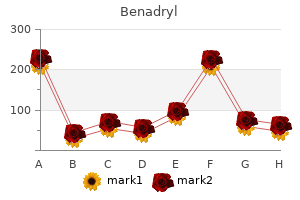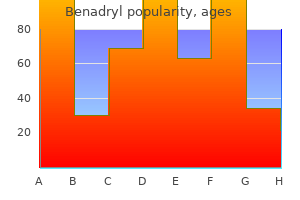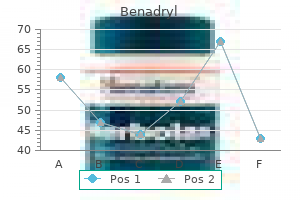"Trusted benadryl 25mg, allergy testing yeast".
By: K. Randall, M.B.A., M.D.
Co-Director, Indiana Wesleyan University
Both studies included only patients with no comorbid drug or alcohol use and included mixed 98 populations with respect to first versus multiple episodes and treatment resistance allergy treatment muscle testing benadryl 25 mg low cost. Drug doses were consistent across studies: 315 mg/d haloperidol versus 520 mg/d olanzapine allergy treatment nhs buy benadryl overnight. The SoE for all the evaluated outcomes was insufficient due to the small number of included trials (Table 74) allergy shots san jose generic benadryl 25mg with mastercard. Improvement in Functional Outcomes allergy shots nyc cheap 25 mg benadryl fast delivery, Decreasing Health Care System Utilization, and Other Outcomes Functional Outcomes Tohen et al. The same trial140 assessed health-related quality of life using the Short Form36 (Table 73). Results showed a significant difference on the mental summary score favoring haloperidol and a significant difference on the physical summary score favoring olanzapine (Table 73). Evidence summary table: haloperidol versus olanzapine (continued) Participants Effect Estimate I2 Favors Other Outcomes Relapse rates140 1 453 0. This trial did not report core illness symptoms, or investigate subgroups (Table 76). No significant differences between groups were found for response rates or remission rates. Evidence summary table: haloperidol versus quetiapine Participants Effect Estimate Other Outcomes Remission rates115 1 201 1. Other outcomes were assessed in single studies and no significant differences were reported. Four trials90, 128, 133, 138 involving 463 adults with bipolar disorder compared haloperidol with risperidone. Key characteristics of the included trials and summary findings are presented in Table 77 and Table 78. All studies restricted inclusion to patients with no comorbid drug or alcohol use. Two studies128, 138 only included patients with multiple episodes; two studies90, 133 included both patients with first and multiple episodes. Dosages for haloperidol ranged from 420 mg/d and for risperidone ranged from 210 mg/d. Duration of followup was 6 weeks in three studies90, 128, 133 and 12 weeks in the fourth. Publication bias was not formally tested for any of the outcomes due the small number of included trials. The SoE for all the evaluated outcomes was insufficient or low due to the small number of included trials (Table 79). Improving Core Illness Symptoms All four trials90, 128, 133, 138 presented results for mood (mania) using two scales. One trial90 (n = 62) assessed mania symptoms using the Clinician-Administered Rating Scale for Mania; no differences between groups were found. Positive and Negative Symptoms 103 Global Ratings and Total Scores Two trials90, 133 presented results for global ratings and total symptom scores using two scales. The study population was mixed with respect to first and previous episodes as well as treatment resistance. Improvement in Functional Outcomes, Decreasing Health Care System Utilization, and Other Outcomes Other Outcomes One trial90 comparing 420 mg/d haloperidol with 210 mg/d risperidone assessed response rates and and found no difference between groups. A significant difference favoring haloperidol was found for the improvement of core illness symptoms, response rates, and for subgroup analysis of disorder subtype (Table 81). The SoE for all the evaluated outcomes was insufficient due to the inclusion of only a single trial (Table 82). The evidence was insufficient to allow conclusions for the remaining comparisons, primarily because only single studies provided data. SoE Insufficient Insufficient Insufficient Insufficient Insufficient Insufficient Insufficient Insufficient Insufficient Insufficient Insufficient Insufficient Low Insufficient Insufficient Insufficient Insufficient 106 Table 83. General Measures Specific Measures No differences were found in single trials reporting the incidence of agitation, 153 depression, 152 and increasing paranoia and excitement. Gastrointestinal No differences were found in the incidence of abdominal cramps (1 trial), 160 constipation (4 trials), 63, 94, 109, 152 diarrhea (1 trial), 160 heartburn (1 trial), 160 and nausea or vomiting (3 trials).


It is important to be attuned to the health of our relationships is a relationships with family allergy shots lymphoma purchase benadryl without a prescription, spouses allergy testing edmonds wa order benadryl with paypal, and friends allergy shots needle size buy benadryl with amex, in critical part to our order to improve our mental health and maintain overall well stability allergy johnson city tn 25 mg benadryl mastercard. The Importance of Supportive Relationships Building and maintaining supportive relationships is a critical part to our overall wellbeing. Connecting and relating to others brings a sense of purpose, meaning, and belonging. With bipolar disorder, it is not unusual for one to isolate and withdraw when depressed. As such, it is vital to work to maintain our relationships throughout our ups and downs to prevent complete detachment in our most critical times of need. When we have strong and healthy relationships with friends, family members, and significant others, we are given an opportunity to learn and grow in a supportive companionship. These relations allow us an outlet to share our fears and aspirations, to enjoy positive and uplifting activities, and to be comforted and consoled when we are struggling. A healthy relationship allows us the opportunity to call on someone for support and assistance when we need it most. The love and support fostered through healthy relationships can in itself be a tool for recovery from mental health symptoms. Engaging in recreational activities or social conversation with others can contribute positive emotions and fend off negative ones. Positive relationships bring us enjoyment in life, and life satisfaction can help ease symptoms of mental health disorders, including bipolar disorder. Improving the Bonds Within Your Family When we are struggling with our mental health, our relationships often suffer. The ones we are closest to , such as spouses, children, parents, and siblings, are pushed away. Instead, reaching out and connecting with those nearest to us will help fight the stress and strengthen our bonds. Supporting our loved ones when they are struggling and allowing them to be there for us will improve the bonds within the entire family. The best time to practice these skills is not while in the midst of a manic or depressive episode. Rather, it is important that you take steps to strengthen your bond before a stressor hits. Maintaining a connection during stable times will help you be strong and prepared for the harder times to come. If you have already injured the bond between you and a family member, you must make the conscious decision whether or not to repair it. It will require you to make a choice as to which behaviors you will no longer engage in to prevent another injury upon the relationship. It might be helpful to engage in therapy to assist you in preparing for this reconciliation process. If you are serious about maintaining and strengthening the bonds with your family members, and even developing new relationships, you should pay particular attention to two things: educating your loved ones about bipolar disorder, and remaining cognizant of your personal impact on your loved ones. Without this mutual understanding, the future of your relationships will be jeopardized. Education About Bipolar Disorder Perhaps the most important aspect to strengthening a relationship after mental health symptoms have caused harm, is education about bipolar disorder. Of course, you must seek out information about bipolar disorder for yourself, but you must also ensure that your loved ones are educated on your condition as well. The more they know about your struggles, the better equipped they will be to assist you when you are in need. In addition, the less inclined they will be to react poorly to stressors about your own behaviors and reactions. Although it is natural for a couple to have periods of decreased communication and intimacy, it is more likely that these periods will be exacerbated by the symptoms of bipolar disorder. Engaging your significant other in a discussion about your diagnosis may assist in alleviating the negative effects it may have on the 93 relationship. Providing literature on bipolar disorder will be beneficial, although explaining your experience in your own words might be most powerful. If possible, and if your spouse is willing, consider inviting him/her into a therapy session so he/she may gather information from a mental health professional. Ongoing couples counseling can also assist in resolving concerns and increasing the bonds between spouses.

Applications to local-area allergy medicine infants purchase benadryl 25mg line, packet-radio allergic reaction treatment order generic benadryl online, local-distribution allergy forecast waco texas buy benadryl paypal, computer and satellite communication networks allergy nebraska order benadryl cheap online. Solution to analysis and synthesis problems which may be formulated as flow problems in capacity constrained (or cost constrained) networks. Development of tools of network flow theory using graph theoretic methods; application to communication, transportation, and transmission problems. Discussion of theory of physical layer and medium access design for wireless communications. Topics include wireless signal propagation and channel modeling, information theoretic studies of wireless models, performance analysis, single carrier and spread spectrum modulation for wireless systems, diversity techniques, multiple-access schemes. Various aspects of physical layer and medium access design for wireless communications systems. Topics include wireless signal propagation and channel modeling, single carrier and spread spectrum modulation for wireless systems, diversity techniques, multiple-access schemes, transceiver design and effects of nonideal components, hardware partitioning issues. Convex optimization methods (interior-point methods, cutting-plane methods, ellipsoid algorithm). Theory and computational procedures for decomposing large-scale optimization problems: cutting-plane methods, column generation, decomposition algorithms. Techniques for global continuous optimization: branch-and-bound methods, reverse convex programming, bilinear and biconvex optimization, genetic algorithms, simulated annealing. Examples from inventory theory, finance, optimal control and estimation, Markov decision processes, combinatorial optimization, communications. Topics in one or more special aspects of communication systems, such as phase-coherent communication systems, optical channels, time-varying channels, feedback channels, broadcast channels, networks, coding and decoding techniques. Treatment of one or more selected topics from areas such as integer programming; combinatorial optimization; network synthesis; scheduling, routing, location, and design problems; implementation considerations for mathematical programming algorithms; stochastic programming; applications in engineering, computer science, economics. Applications of variational methods, Pontryagin maximum principle, Hamilton/Jacobi/Bellman equation (dynamic programming) to optimal control of dynamic systems modeled by nonlinear ordinary differential equations. Response of linear systems to random inputs: discrete-time and continuous-time models. Statistical estimation theory: maximum likelihood principle, optimum mean square estimation, conditional expectation, Wiener/Hopg equation, Gaussian signals and Gram/Schmidt orthogonalization, factorization, maximum unconditional likelihood. Kalman filter: basic theory, error propagation/steady state convergence theory, examples, applications to system parameter identification, Kalman filtering software. Linear quadratic Gaussian theory of optimal feedback control of stochastic systems; discrete-time state-space models; sigma algebra equivalence and separation principle; dynamic programming; compensator design for time invariant systems; feedforward control and servomechanisms, extensions to nonlinear systems; applications to interception guidance, gust alleviation. Requisite: course M240A or Chemical Engineering M280A or Mechanical and Aerospace Engineering M270A. Liapunov theory (including converse theorems), invariance, center manifold theorem, input-to-state stability and small-gain theorem. Multivariable robust control, including H2 and H-infinity optimal control and robust performance analysis and synthesis against structured uncertainty. Presentations of research topics by leading academic researchers from fields of systems, dynamics, and control. Thorough treatment of one or more aspects of control theory and applications, such as computational methods for optimal control; stability of distributed systems; identification; adaptive control; nonlinear filtering; differential games; applications to flight control, nuclear reactors, process control, biomedical problems. Advanced treatment of concepts in electrodynamics and their applications to modern engineering problems. Rectangular and circular waveguides, microstrip, stripline, finline, and dielectric waveguide distributed circuits, with applications in microwave and millimeter wave integrated circuits. Computational techniques for partial differential and integral equations: finite-difference, finite-element, method of moments. Applications include transmission lines, resonators, integrated circuits, solid-state device modeling, electromagnetic scattering, and antennas. Preparation: modern physics (or course 123A), linear algebra, and ordinary differential equations courses. Principles of quantum mechanics for applications in lasers, solidstate physics, and nonlinear optics. Microscopic and macroscopic laser phenomena and propagation of optical pulses using classical formalism. Nonlinear pulse generation: soliton laser, additive-pulse mode locking, and parametric oscillators.

Syndromes
- Congestive heart failure
- Chromosome studies
- Hypernatremia
- Infection
- The MAGIC Foundation: www.magicfoundation.org
- Abnormal growth of cells in the bone marrow (myeloproliferative disorders)
Along with the financial benefits of the industry allergy medicine japan order genuine benadryl online, there are a number of environmental issues associated with the production of ornamental plants allergy testing des moines benadryl 25mg fast delivery. Ornamental production operations typically have high rates of nutrient and irrigation inputs allergy shots price discount benadryl line, especially in greenhouse and container-nursery operations [2-6] allergy medicine that starts with l discount benadryl 25mg free shipping. Frequent irrigation combined with high fertilizer and pesticide use can lead to significant losses of agricultural chemicals in runoff water, which transports chemicals to containment structures, groundwater or surface water [7-9]. Irrigation water management is the key to nutrient management in ornamental crop production and reducing the impact of runoff water on local water resources [10, 11]. Due to these variables, writing water and nutrient management plans requires a risk assessment approach, which has the advantage of allowing the grower to design and implement site-specific best management practices for the entire operation [10]. There is also a major concern across the country about reduced irrigation allocations for the nursery and greenhouse industry, and increased regulation of nutrients, sediment, and pesticides and other chemicals in runoff water [5]. Although the nursery and greenhouse industry makes up a relatively small amount of the overall farmland in the state, many operations are intensively managed, especially greenhouse and container operations. This leads to the potential for high levels of nutrient and sediment runoff if proper nutrient application and abatement practices are not followed. To understand the complexities of irrigation and application practices in nursery and greenhouse operations in Maryland, site visits were conducted around the state. A total of 47 container, field and greenhouse operations voluntarily agreed to participate in this project, out of approximately 350 operations in the state. Growers were interviewed for 2-3 hours, and provided detailed information about irrigation and nutrient application rates and timings, as well as various best management practices that were used. A management unit can be defined as the same or similar species of plants that have similar container sizes and cultural conditions. There may be any number of management units at an operation, depending on its size and complexity, and how the various plants that are grown are managed. These data were separated into three databases for greenhouse, container nursery and field nursery. Some data, such as pounds per acre per year of nutrient were derived from the information provided by growers. If the grower applied a range of rates to a particular management unit (for example fertigation was applied 3-5 times a week), the information presented in this paper is the maximum application rate. This was done to maintain uniformity in the data, and represents the maximum amount of nutrients that would be applied during a typical crop cycle. If different rates were applied during a typical crop cycle (for example lower rates for the first of the cycle, and a higher rate thereafter), that information is reflected in the data presented here. In this paper, we focus specifically on our major findings for container- and field nursery operations. Results and Discussion: Container-nursery operations: Irrigation application rates for container nurseries in this study are reported in Table 1. Irrigation rates for container-nursery operations were much higher than for greenhouse, especially at the upper quartile rates of 34, 810 and 38, 075 gal/application for spring and summer respectively (Table 1) compared to greenhouse operations which had an upper quartile rate of 9, 253 gal/application ([13] data not shown). Irrigation rates are likely higher in container-nursery operations, since plants are typically more widely spaced, container sizes are often larger, and overhead irrigation is widely used, which decreases interception efficiency compared to greenhouse operations. Nevertheless, upper quartile rates that are being applied (Table 2) are likely in excess of plant needs, which increases the potential for nutrient runoff from container-nursery operations. Plants that were grown using the average and lower quartile rates had similar production times compared to the upper quartile rates, and were likely meeting plant nutrient requirements (data not shown). It should be noted that rates reported for Tables 2 and 3 were not adjusted for plant densities, although similar spacings were used for the same container size or type of tree grown. The upper rates in Table 2 are likely in excess of plant needs, and could be reduced to realize financial savings, and reduce nutrient runoff. It is likely that container-nursery growers could reduce application rates to many plant species to at least average rates (Table 2) without any reduced growth or increase in production time. This would save money, and would reduce nutrient runoff over higher application rates, as indicated by water and nutrient models that have been developed, as part of this study [10; data not shown]. We noted some interesting comparisons between greenhouse and container operations. Greenhouse grown mums (using mainly soluble fertilizer) had an upper quartile rate of 431 lb of N/ac/yr and 477 lb of P/ac/yr [10]. Plants are produced in similar container sizes in approximately the same amount of time, and are of similar quality.
Discount benadryl line. When to Introduce Gluten to Children - Celiac Disease in the News.


